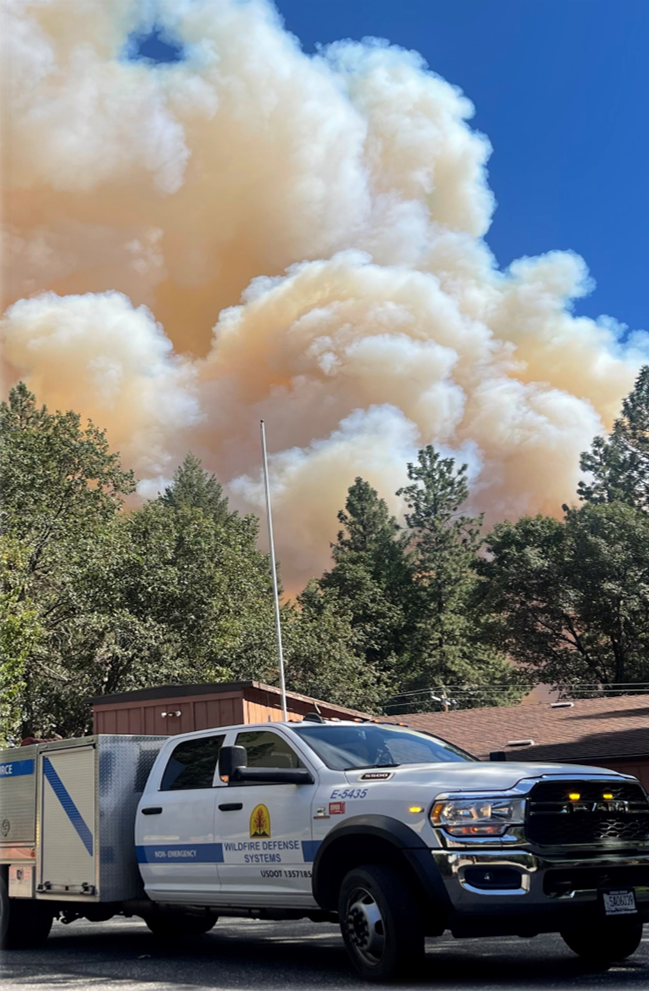On a busy day at the headquarters of Wildfire Defense Systems (WDS) in Bozeman, Montana, staff are tracking wildfires across 22 US states. At the peak of summer, there can be over 250 ignitions a day. Some will come to nothing; some will be suppressed by local fire crews; and some, driven by high winds and tinder-dry vegetation, will escalate in scale and ferocity to the point at which they become a major threat to property. That’s when the team at WDS takes action.

A new response to the growing threat of wildfires

Founded in 2008, WDS is a private sector wildfire service that protects properties on behalf of the insurance companies who insure them.
“We’re not first responders, our job isn’t to fight the fire but to protect structures. The fire will be in contact with a building for 2–10 minutes. We prepare the property in advance so it can survive those minutes.”CEO and founder David Torgerson, originally a civil engineer by trade.
According to the United States Environmental Protection Agency, there are, on average, 70,000 wildfires in the US each year. While the number of wildfires has not risen markedly, the area of land burned by these fires seems to have increased. In 2017, the worst year on record, damage from wildfires was estimated at $24 billion. Fire suppression alone now costs the US Federal Government, on average $2.8 billion per year.
In California, the situation is more severe. According to WDS, recent years have seen increases in both frequency and severity of California wildfires as a result of climate change and the growth of communities in formerly rural areas. Following major insurance losses in 2017–2020 and 2021, the cost of property insurance in the state rose to the point that an ‘insurance crisis’ ensued.
WDS’s response was to launch a new syndicate at Lloyd’s – Wildfire Defense Syndicate 1996 – focused solely on an insurance solution for California Commercial Excess & Surplus wildfire prone property . The plan is to provide insurance cover to commercial businesses in California that are unable to buy insurance through the usual channels because of the high level of risk they pose.
Because of the highly innovative and niche nature of WDS’s California wildfire solution, the firm has chosen to enter the Lloyd’s market as a syndicate in a box (SIAB) – a new option created by Lloyd’s to allow smaller, entrepreneurial businesses to become part of the Lloyd’s insurance market without having to contend with regulatory and financial conditions designed with much larger insurance businesses in mind. Regulatory reporting requirements have been reduced; some contributions to Lloyd’s Central Fund have been deferred, but in return, the SIAB is restricted in what type of risks it can underwrite and must achieve certain financial criteria by its third year of trading.
“Having a syndicate in a box gives us the ability to write risks of a substantial nature, Lloyd’s is highly respected in our industry so having its name on our paper gives us great credibility. With Lloyd’s, we can keep California businesses in operation, protect them from loss, provide for business continuity and reduce wildfire economic impact to society. For every policy written in Wildfire Defense Syndicate 1996, the commercial policyholder has an endorsement on their policy which gives the right, but not the obligation, for a wildfire response.”Michael Ray, WDS’s executive vice president
In some ways, WDS’s offering mirrors the late 1800’s origins of commercial insurance when paid fire-fighting services were the norm; but the firm’s use of cutting-edge monitoring technologies, its technical expertise and science such as fire modelling and the application of fire-retardant gels to properties are a 21st century response to an age-old problem. According to David Torgerson, today WDS’s offering is supplemental to work done by local, state and federal agencies and provides for a scalable contribution to reducing the structure loss in a climate change environment.
Meanwhile, back in Bozeman, Montana, red dots on the screens at WDS’s headquarters indicate the firm’s next 100 monitored fires.
“Once we service a property, we have a more than 99% success rate that it will survive a fire, and we’ve tracked over 100,000 wildfire ignitions since 2013.”David Torgerson, CEO and founder